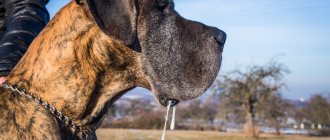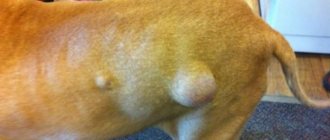Inflammatory processes can occur in the body of pets, just like in humans. During inflammation, entire lesions and ulcers are formed. One of the most painful types of inflammation is an abscess.
The appearance of a purulent lesion can be localized in any part of the pet’s body. In the absence of timely treatment, the abscess can grow to truly enormous sizes, causing the animal not only discomfort, but also pain.
It is necessary to understand what factors can lead to the development of an abscess, what types of lesions exist, and in what cases it is important to urgently contact a veterinary clinic to see a specialist. Otherwise, there is a risk of developing serious complications.
Abscess in a dog
An abscess in a dog is a cavity of limited size filled with pus, most often formed by penetrating wounds and infection in the subcutaneous tissue. Appears as a consequence of purulent decay (necrosis) of tissue. A visible abscess is superficial and is a soft, moderately painful swelling with an infiltrate. The breeder cannot diagnose internal abscesses on his own; they are usually found by chance during examination.
Varieties
The following types of abscesses are distinguished:
- Benign. As a rule, the result of unsuccessful vaccinations, injections, blows and injuries. It looks like a reddish swelling, the cavity of which is filled with thick purulent liquid.
- Malignant. It looks like watery red bumps that are not elastic to the touch, inside of which there is liquid pus.
- Cold. The cone ripens slowly and almost never opens spontaneously. As a rule, this is a “diagnosis” of old dogs with weak immunity.
- Hot. It forms quickly and is accompanied by an increase in body temperature. The swelling is painful and often opens on its own.
Types of abscesses by location
Depending on the location of the abscess, abscess in dogs can be:
1. Superficial. It is formed under the epidermis and does not pose a direct threat to the life and health of the pet. The pathological process practically does not affect the blood vessels, so the likelihood of sepsis is excluded.
2. Deep. It captures the fat layer and muscle tissue, it is difficult to notice visually, especially under thick fur, only with careful palpation.
3. Odontogenic. It is found in the oral cavity when gums and soft tissues are damaged.
4. Paraanal. Develops as a result of inflammation of the paraanal (under the tail, on the sides of the anus) glands.
There are also other inflammatory and purulent neoplasms that are located on the head, neck, torso, in the groin area and on the paws.
Table No. 1. Types of abscesses according to clinical signs.
| Forms | Characteristic |
| Superficial | It looks like a small pimple with purulent contents, often opens on its own and does not pose a threat to health. |
| Cold | Chronic course with frequent relapses. |
| Deep | Located in muscle tissue, deep layers of the epidermis. Requires immediate treatment in a veterinary clinic. |
| Acute | If you do not contact a veterinarian in a timely manner, it spreads rapidly, involving healthy tissue and the likelihood of sepsis. Requires immediate opening, cleaning and general treatment. |
| Malignant | It most often develops in dogs with low immunity, young or old animals, with systemic pathologies or with insufficient care for the pet. |
| Benign | Upon opening, a yellow or whitish discharge appears. It responds well to treatment. |
Prevention of purulent bumps
The problem is easier to prevent; treating purulent bumps is difficult. What is needed for this:
- Carefully follow the rules of hygiene;
- Regularly examine the dog, promptly identify problem areas;
- Treat even the smallest wounds;
- Recommendations for caring for animals must be followed;
- Bring your dog to the clinic for examination regularly.
It is naive to believe that the abscess will resolve on its own. In a short time, a pet's body can become infected, and if timely assistance is not provided, blood poisoning can lead to death.
Currently reading:
- Causes of inflammation of the salivary gland in a dog's mouth
- The American Cocker Spaniel is an adroit hunter and loyal friend.
- Is it worth it or not to include natural food in your dog’s diet?
- 8 ways to treat papillomas on a dog’s body
What happens inside (pathogenesis)
With abscesses, the pathological process develops according to a similar type of simple purulent inflammation. However, it has its own characteristics that distinguish the localized (limited) form from other types of purulent inflammation.
In the focus of the abscess, necrotic (dead, dead) tissues undergo lysis (melting under the influence of enzymes). As a result, a cavity is formed with pus, tissue debris, microorganisms and their waste products.
An inflammatory infiltrate appears around the purulent base-cavity, from which an abscess wall is formed. It consists of fibrous connective tissue (outer wall) and granulation tissue (inner), such a barrier is relatively strong and isolates the purulent cavity from healthy tissue.
Reasons for development
An abscess can develop as a result of:
· Penetration of pyogenic bacteria into damaged tissues.
· Injections, blood transfusions if antiseptic rules are not followed.
· Transfer of pathogenic microflora by lymph and blood from internal inflammatory foci.
· Suppuration of hematomas.
The main cause of abscess formation is trauma and developing inflammation. With a brain abscess, the root cause is pathological processes in the inner ear, mouth, and sinusitis. Liver abscess occurs with omphalophlebitis (inflammatory process in the umbilical vein), suppuration in the lung - as a consequence of bacterial pneumonia, aspiration. Abscess of the mammary glands in bitches - after mastitis.
With inflammation of the oropharynx, an abscess can appear in the dog’s eye area, and subcutaneous abscesses are a consequence of skin damage caused by fights, bites or wounds to the skin.
Immunodeficiency conditions (decreased immunity due to an acquired or congenital disease) can also contribute to the formation of an abscess in the body.
Important! In the absence of treatment, as well as in case of poor removal of pus or its resorption, a dense fibrous membrane forms around the abscess. The pressure inside the capsule increases, the skin ruptures and a fistula forms.
The long-term existence of an abscess leads to its rigidity, the fibrous wall grows, becomes thick, and the abscess cavity is filled with granulation tissue. In this situation, the disease takes on a chronic form, the abscess does not bother the dog, and pus will periodically flow out through the open fistulous tract.
TOP causes of abscess:
1. Fights, biting.
2. Eating small, sharp (especially chicken) bones, wounding the mucous membrane of the mouth.
3. Lack of dental hygiene.
4. Punctures (abscess on a dog’s paw) of the pads, wounds from branches, wire, thorns, etc.
5. Unqualified medical manipulations and non-compliance with the rules of asepsis and antisepsis.
All these reasons do not always lead to the formation of an abscess; it all depends on predisposing factors - the depth of damage, contamination of the wound with pathogenic microflora.
Consequences of non-treatment
If the owner treats his pet irresponsibly, an abscess can result in various complications and consequences for the dog. Failure to treat external problems leads to infection of the subcutaneous areas and abscess of the animal’s internal organs. Often, due to lack of attention to the disease, sepsis develops - systematic blood poisoning with infections.
Deep abscesses open inside the body, and pus leaks into the dog. Pus entering the abdominal cavity can lead to peritonitis.
Failure to treat any form of abscess will most likely result in the dog's premature death.
Course and clinical signs
Regardless of whether the abscess has formed on the dog’s paw or in another place, there are: cold, metastatic, hot and septic types of abscess. These are the most common species found in veterinary practice.
Signs:
· Hot.
In the first 4-5 days, a limited, reddened, painful and swollen spot with a doughy consistency is visible on the skin. After a couple of days, the swelling is clearly formed, with pronounced contours; if you press on the center of the swelling, softening of the tissue is clearly visible under your finger. By the 10th day, a fluctuation is detected; at the site of lysis (melting of tissues), the skin becomes thinner, breaks out, and pus pours out. The abscess cavity gradually granulates.
· Chronic (cold).
There are no signs of an acute inflammatory process; the abscess develops slowly. The dog does not have a fever; a slight swelling, fluctuation and soreness forms on the skin. The pus is pale yellow.
· Sinter.
This is a consequence of a cold abscess, when purulent inflammation spreads through the loose connective tissue space to the first fascial barrier. The pus lingers there, forming a secondary cavity filled with pus.
· Metastatic.
In this case, a mass of pathological foci are found in the dog’s body, forming a general purulent infection (abscesses, phlegmon). From these foci, through the blood and lymph flow, pathogenic bacteria spread to healthy tissues (usually parenchymal organs), where multiple secondary abscesses are formed.
How can a dog owner identify an abscess?
A pathological neoplasm is formed over several stages and the main task of the breeder is to recognize it as early as possible and contact a veterinary clinic.
Signs that can help identify an abscess:
· Redness of mucous membranes and skin areas.
· Swelling, the more pus in the developing cavity, the more pronounced it is.
· Fluctuation (feeling like there is a balloon with water or cream under your fingers).
· Alopecia (hair loss; the thinner the skin becomes and the faster the tissue dissolves under pus, the larger the bare area of the body).
· Necrosis (tissue death).
If you do not contact a veterinarian in a timely manner, the abscess ruptures, its contents pour out, and in critical cases the pathological condition begins to progress. A general infection of the body begins (sepsis, the formation of new ulcers).
Important! If there is an abscess, the dog’s condition worsens, appetite is reduced, general malaise and weakness are observed. The more advanced the process, the worse your health becomes.
Diagnostics
Usually diagnosing the disease is not difficult, the visual picture is clear. When palpating (feeling) the neoplasm under the fingers, a characteristic swelling and fluctuation is felt. If the abscess has opened, pus flows out, there is a cavity with its remains and inflammation in the adjacent tissues.
For deep-lying cavities, a diagnostic puncture is made with a sterile needle in a veterinary clinic and in compliance with antiseptic rules.
When the process is chronic (cold abscess), the diagnosis is made based on clinical signs (minimal inflammation, swelling, slight pain) and puncture results.
General symptoms are helpful in making a diagnosis. Their severity depends on the localization of the pathological focus, its spread throughout the body, the degree of neglect and the strength of the dog’s general immunity.
Treatment practice
Treatment of an abscess in a dog consists of ensuring a constant drainage of pus from the cavity, thoroughly cleaning it, and rinsing it. In case of an unopened abscess, the skin is incised in 2 projections - at the lowest and highest point of the cavity. Drainage (tubes, tapes) is inserted into the incisions. All manipulations are carried out under general or local anesthesia; it all depends on the location of the abscess, its size, and the dog’s reaction to the veterinary surgeon’s manipulations.
The cavity is constantly sanitized (washed) with disinfectants until complete healing. As soon as the “dried” abscess closes, the tubes are removed. It will take up to 10 days until the wound is completely healed and tissue is restored.
For internal abscesses, surgical (abdominal) surgery will be required. Systemic antibiotic therapy is mandatory for up to 2 weeks. During treatment, the dog is put on a protective collar, bandage, blanket - the main thing for the breeder is to ensure that it does not reach the drainage tube or wounds.
When to see a doctor
It is necessary to urgently visit a veterinarian in the following cases:
- the affected area of the animal began to rot, the surrounding tissues began to turn black;
- the dog is restless, howls, licks an abscess;
- with active treatment, inflammation does not go away within a week;
- an abscess appeared on the ear, near the eye, genitals and anus.











